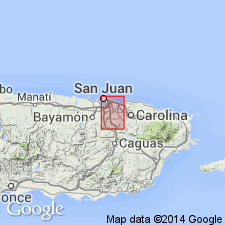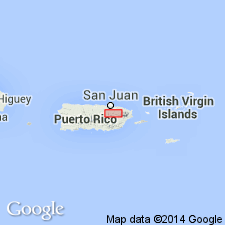
- Usage in publication:
-
- Tortugas andesite*
- Modifications:
-
- Named
- Dominant lithology:
-
- Andesite
- AAPG geologic province:
-
- Caribbean region
Summary:
The Tortugas andesite, here named, was included in the Guaynabo, Luquillo, and Fajardo formation of Meyerhoff and Smith (1931). Consists of a persistent horizon of flow rocks, breccia, and conglomerate, all of augite-andesite composition, lying between the Guaynabo formation, here redefined, and the Frailes formation. Contains blocks of sedimentary rocks containing Late Cretaceous fauna. Thickness varies from 0 to 1,300 ft. Age is Late Cretaceous.
Source: GNU records (USGS DDS-6; Reston GNULEX).

- Usage in publication:
-
- Tortugas Andesite*
- Modifications:
-
- Principal reference
- Revised
- Age modified
- AAPG geologic province:
-
- Caribbean region
Summary:
The Tortugas Andesite of Kaye (1959) is here revised to include volcanic breccia overlying the Camarones Sandstone previously included by Kaye in the Frailes Formation. Consists of mottled greenish- to reddish-gray lava fragments in a matrix of smaller lava fragments. Intertongues to the northwest with upper part of the Guaynabo Formation. Age is Late Cretaceous (Coniacian, Santonian, to Campanian).
Source: GNU records (USGS DDS-6; Reston GNULEX).

- Usage in publication:
-
- Tortugas Andesite*
- Modifications:
-
- Overview
- AAPG geologic province:
-
- Caribbean region
Summary:
The Tortugas Andesite occurs in eastern Puerto Rico and consists of volcanic breccia, subordinate lava, volcanic sandstone, and conglomerate. Maximum estimated thickness is 700 meters. The Tortugas is of Late(?) Cretaceous age.
Source: GNU records (USGS DDS-6; Reston GNULEX).
For more information, please contact Nancy Stamm, Geologic Names Committee Secretary.
Asterisk (*) indicates published by U.S. Geological Survey authors.
"No current usage" (†) implies that a name has been abandoned or has fallen into disuse. Former usage and, if known, replacement name given in parentheses ( ).
Slash (/) indicates name conflicts with nomenclatural guidelines (CSN, 1933; ACSN, 1961, 1970; NACSN, 1983, 2005, 2021). May be explained within brackets ([ ]).

